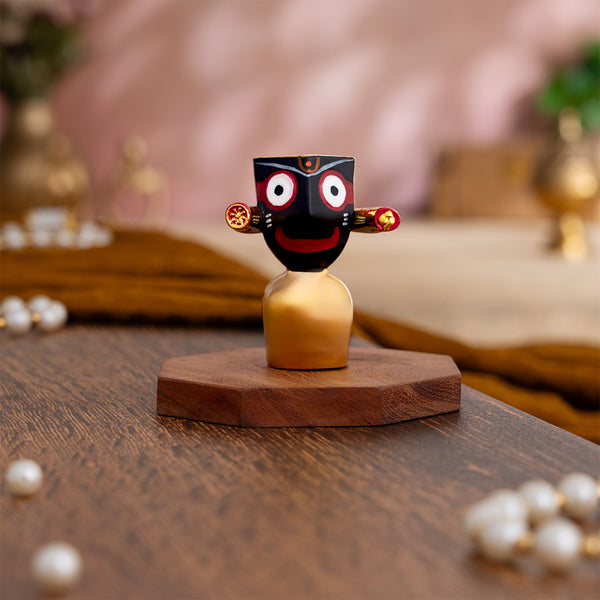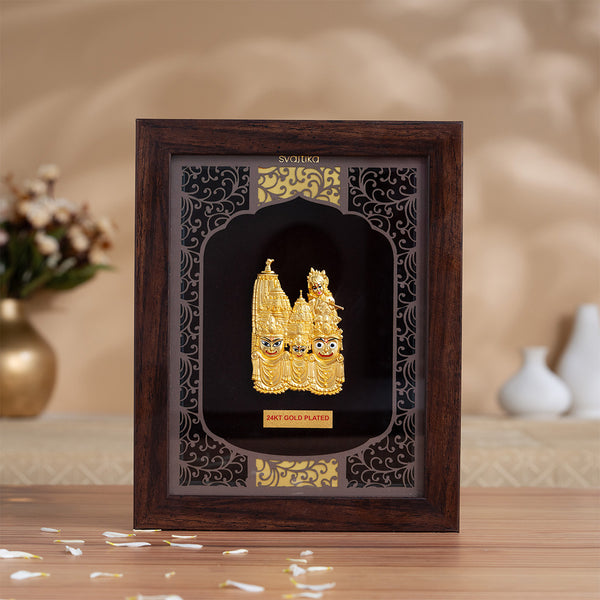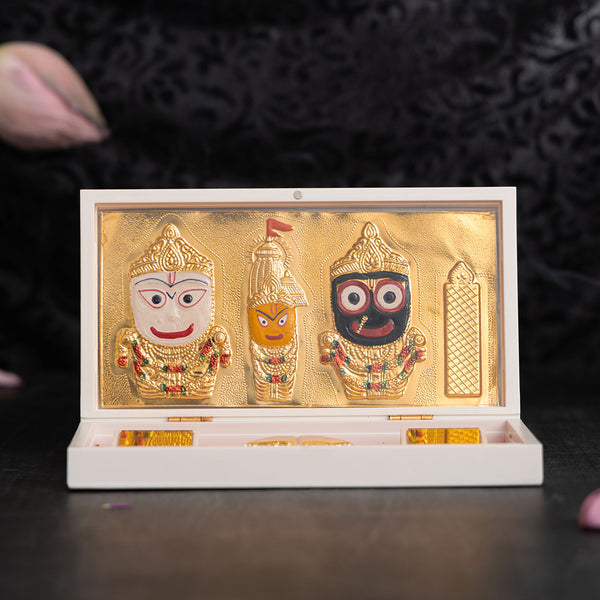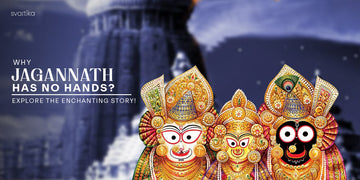With a vast and rich culture and heritage attributed to our religion, we have no lack of beautiful stories woven for our deities.
And we’re going to be looking into the origin, history, powers, and lore of Lord Jagannath. Indian Gods and Goddesses take several forms and names.
Have you ever seen a deity depicted without hands? That's Lord Jagannath, a revered Hindu god worshipped in Puri, India.
His iconic idol is unlike any other, with a distinct style and a fascinating story behind its creation.
In the Indian states of West Bengal and Puri, Odisha (also known as Orissa), the Hindu god Krishna is venerated as Jagannatha (Sanskrit: "Lord of the World").
The city of Puri is dominated by the 12th-century Jagannatha Temple. The sanctuary of the temple contains wooden statues of Jagannatha, his sister Subhadra, and their brother Balarama.
His idol breaks the mold, standing tall with a simple, almost childlike form, and most strikingly – no hands. This unique feature sparks curiosity and whispers of a fascinating story behind its creation.
Lord Jagannath Murti - Gold Plated (2.75 Inch) Lord Jagannath Puri 3D Wall Frame - Gold Plated Finish

The Captivating Legend of Lord Jagannath's Missing Hands
The legend of Lord Jagannath's missing hands is as captivating as the deity himself.
The story goes that King Indradyumna, a devout follower of Lord Vishnu, desperately craved to see the god in physical form.
Through divine intervention, he learned that Lord Vishnu had taken the form of the Nila Madhava idol. Ecstatic, the king rushed to see the deity, but alas, upon arrival, the idol had vanished!
Disheartened but not defeated, Indradyumna received a message – build a temple on top of Nila Hill.
Here's the interesting part: the king was instructed to find a skilled craftsman to carve a new idol, but with one crucial caveat – the work had to be completed in a single night!
The king, determined to please the Lord, sought out the legendary Vishwakarma, the divine architect.
Vishwakarma, renowned for his speed and skill, agreed to the challenge. He set to work with a fervour that shook the very foundations of the night.
As dawn approached, the magnificent idol of Lord Jagannath was nearly complete, except for one crucial detail – his hands!
Just as Vishwakarma was about to put the finishing touches on the idol, the first rays of the sun peeked over the horizon.
Now, King Indradyumna, bless his impatient heart, might have peeked in a few times during the night, making Vishwakarma a tad nervous about the deadline.
So, seeing the first light, Vishwakarma, fearing he'd failed, simply left the idol unfinished.

Indradyumna, upon seeing the handless Jagannath, was devastated.
But then, a booming voice filled the air! It was a divine voice, folks, and it declared that the idol, in its unique, incomplete form, was perfect.
Why? Because, the voice explained, Lord Jagannath, with his missing hands, symbolized the universality of the divine.
He was a god who didn't need hands to offer blessings or embrace his devotees. His love encompassed all, regardless of form.
And so, the handless idol became a revered symbol of faith, a constant reminder that true devotion transcends physical limitations.
It's a captivating story that continues to inspire millions of devotees who flock to Puri to see Lord Jagannath in all his magnificent, handless glory.
Why Lord Jagannath Has No Hands : Symbolic Interpretations

The missing hands of Lord Jagannath are more than just a captivating legend; they hold deep symbolic meaning for devotees.
Here are some interpretations offered by scholars and believers :
Universal Embrace : One interpretation suggests that Lord Jagannath's handless form signifies the all-encompassing nature of the divine.
He doesn't need hands to offer blessings or embrace his devotees – his love extends to all, regardless of form or action.
Beyond Action : Another interpretation views the missing hands as a symbol of the divine being beyond the limitations of physical action.
He is the source of all creation, yet remains unattached to the act of creation itself.
Inner Strength : Some see the handless form as a call for devotees to cultivate inner strength and rely on their own actions.
Lord Jagannath doesn't physically intervene, but guides through wisdom and inspiration.
Acceptance and Completion : An interesting interpretation suggests that the unfinished idol represents the ever-evolving nature of the divine.
We, as devotees, are invited to participate in the completion of the divine through our own devotion and spiritual growth.
These are just a few of the many interpretations associated with Lord Jagannath's handless form. The beauty lies in the openness to personal reflection.
The missing hands become a powerful symbol, prompting devotees to explore their own connection to the divine and the nature of true devotion.
Cultural and Artistic Representations of the Handless Idol

Lord Jagannath's handless form transcends religious significance, weaving itself into the very fabric of Puri's cultural and artistic identity.
Here's a glimpse into how this unique depiction finds expression across various art forms :
Sculptural Majesty : The most prominent representation, of course, is the idol itself. Crafted from wood with intricate details and vibrant colors, the handless form is a masterpiece in, the art of wooden craftsmanship.
Jagannath's handless posture is replicated in countless smaller sculptures, serving as a reminder of the deity in homes and community spaces.
Painted Devotion : Jagannath paintings are a vibrant art form in Puri. Using natural pigments and adhering to traditional styles, artists depict the Lord in various scenes from his legends.
While the handless form remains a constant, it's often adorned with rich jewelry and symbolic decorations, adding depth to the artistic narrative.
Architectural Grandeur : The Puri temple itself stands as a testament to the artistic reverence for Jagannath.
The intricate carvings and towering structure reflect the importance of the deity in the region's architectural heritage.
Interestingly, some architectural elements within the temple complex echo the handless form, subtly reinforcing its significance.
Festival Flourish : The annual Rath Yatra festival is an explosion of color and devotion.
The colossal chariots carrying the idols of Jagannath, Balabhadra, and Subhadra are themselves works of art, adorned with intricate paintings and carvings that reiterate the iconic handless form.
Even the temporary structures built during the festival incorporate design elements that pay homage to Jagannath's unique depiction.
Lord Jagannath's handless form is more than just a physical characteristic; it's a cultural touchstone.
It permeates every aspect of artistic expression in Puri, serving as a constant reminder of the captivating legend and the profound spiritual significance it holds for devotees.
The Annual Rath Yatra and Its Connection to Lord Jagannath's Handless Form

The Rath Yatra festival in Puri explodes with color, music, and joyous devotion, but beneath the celebratory surface lies a deeper connection to the captivating legend of Lord Jagannath's missing hands.
Buckle up, because we're about to unravel how this unique feature plays a symbolic role in the festival's grand rituals.
The Rath Yatra, in a way, symbolically retells the story every year. Here's how it weaves the legend into the vibrant tapestry of the festival :
The Journey Begins : The festivities kick off with the construction of three colossal chariots – one each for Jagannath, his brother Balabhadra, and their sister Subhadra.
These aren't your average parade floats; imagine towering structures adorned with intricate carvings and vibrant colors, befitting the divine riders they carry.
The Helping Hands Dilemma : Now, here's the interesting part. Traditionally, the chariots are supposed to be pulled by devotees, a massive display of collective faith.
But there's a slight snag – how can devotees pull the chariots when their beloved Lord Jagannath has no hands to hold the reins?
Divine Intervention : This is where the legend and the festival beautifully intertwine. A special team of priests steps in, acting as the symbolic missing hands.
With meticulous care, they maneuver the gigantic chariots through the throngs of devotees, signifying how devotees assist the divine will even without physical contact with the idol.
A Celebration of Completion : As the chariots reach their designated spots, it's seen as the culmination of a celestial journey.
It's a moment of immense joy, a reminder that even though the idol might be unfinished, our devotion and participation complete the divine experience.
The Rath Yatra becomes a vibrant enactment of the legend, a celebration of unwavering faith, and a way for devotees to feel a deep connection with the divine, even if their Lord has no hands to reach out and touch them.
So, the next time you see visuals of the Rath Yatra, remember, it's not just a spectacular parade.
It's a story retold, a bridge built between devotees and the divine, all revolving around the captivating legend of Lord Jagannath and his unique form.
Lord Jagannath, Subhadra, Balabhadra Murti Set - Gold Plated (4 Inch) Svastika Jagannath Pocket Temple - Gold Coated

Conclusion
The legend of Lord Jagannath's missing hands is more than just a fascinating story, it's a captivating window into the rich cultural and spiritual heritage of Puri.
From the symbolic interpretations of his form to the artistic expressions that permeate the region, Jagannath's handlessness transcends religious significance.
Scholars and devotees interpret the missing hands as a universal embrace of the divine, a symbol transcending physical action, a call for inner strength, or an invitation to participate in the completion of the divine through devotion.
The annual Rath Yatra festival further strengthens this connection.
The elaborate chariots and the symbolic role of the priests acting as "missing hands" beautifully reenact the legend, reminding us that devotion itself completes the divine experience.
Lord Jagannath's handless form is a powerful reminder that true faith transcends the physical.
It invites us to appreciate the captivating legend, the profound symbolism, and the vibrant cultural tapestry it has woven in Puri.
So next time you encounter this unique deity, remember the story behind the form, and allow yourself to be captivated by the magic of Jagannath.
FAQs
1) What is the spiritual meaning behind Lord Jagannath’s family lineage?
-
Lord Jagannath is worshipped with his siblings, Balabhadra and Subhadra, symbolizing divine unity and the importance of family in spiritual life.
2) Why was Lord Jagannath’s idol left incomplete by the sculptor?
-
According to legend, the sculptor left the idol incomplete because the king broke his promise by interrupting the divine work. The unfinished form is now seen as sacred and full of meaning.
3) Which website is best to buy Jagannath idol online?
-
Svastika.in is a great place to buy Jagannath idols online. They offer handcrafted, traditional idols with spiritual authenticity and quality.








